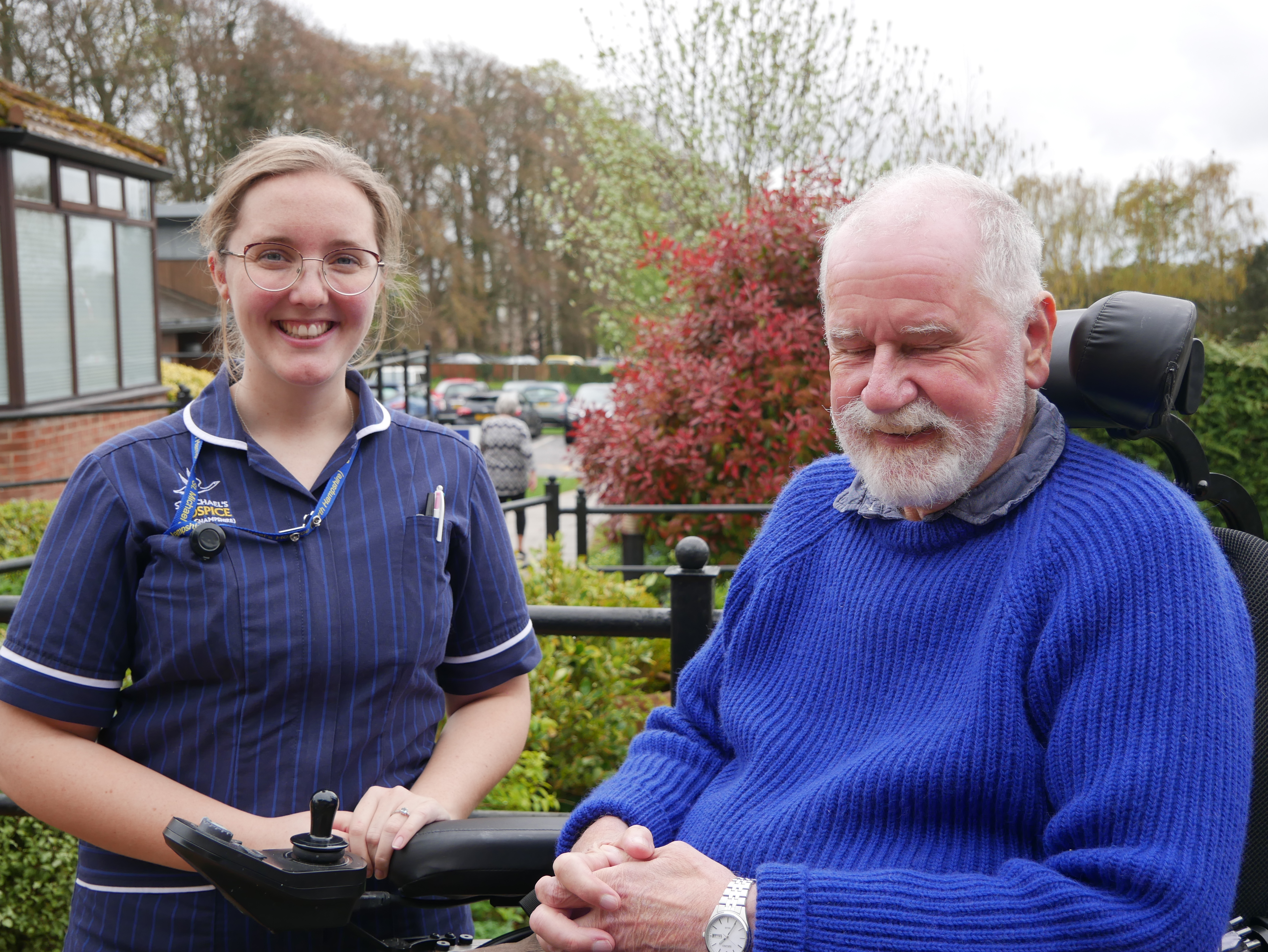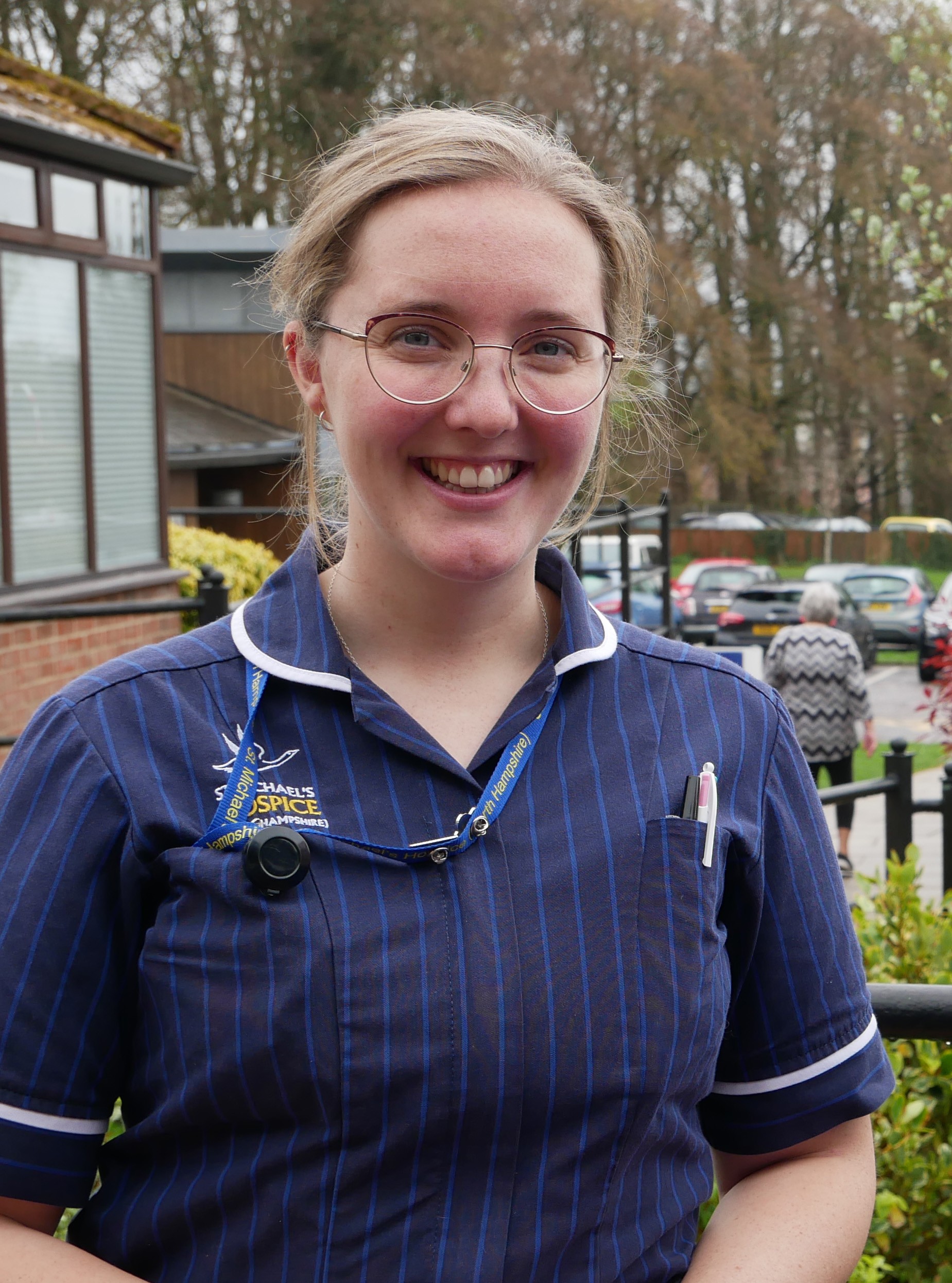
A day in the life of…Ellie – a Hospice at Home nurse
written by Ellie Morgan
A day in the life of a Hospice at Home nurse
Read all about a day in the life of me, Ellie, a Hospice at Home nurse at St. Michael's Hospice.
Ellie, a nurse in our Hospice at Home team has shared a day in her life at work! Read on to find out what her role involves on a daily basis.
08:15 – I arrive at the office early for my 08:30 start, make a cup of tea and catch up with my colleagues.
09:00 – I join a video call with my colleagues in the Community Palliative Care Team, In-Patient Unit and Hospital teams. Here we discuss In-Patient Unit capacity, possible admission, overnight calls and Hospital admissions and discharges.
09:15 – I walk over to the Wellbeing room where I join the wider Community Palliative Care Team to attend a referral meeting. Here we discuss and allocate the patients that have been referred to the palliative service by their GP or Hospital discharges.
10:00 – Duty calls as a telephone call comes into the Hub from John, who tells me his wife, Dawn, has deteriorated and can no longer get out of bed. After this call, I re-organise my day to prioritise this urgent visit. I then visit Dawn at home, who has deteriorated rapidly, and is very weak and lethargic. We discuss additions of equipment with Dawn and her family to make Dawn comfortable at home. We also discuss her package of care (POC) and conclude that due to the deterioration, Dawn will require visits from carers four times a day.
Usually, I would attend the Multidisciplinary Team caseload review at this time, so my colleague goes on behalf of Hospice at Home.
12:30 – Once back in the office, I liaise with our Occupational Therapy Team to discuss equipment required for Dawn. After their very helpful input, I use the local equipment service provider to order a profiling electric bed to be delivered to Dawn’s home, this will make her more comfortable now she’s spending more time in bed.
I call the Continuing Health Care (CHC) to discuss increasing Dawn’s POC to support with her changing symptoms. As an advisory service to Primary Care, I email the patient’s GP to update them on Dawn’s deterioration and request additional medications for an injection that makes up the Just In Case “JIC” medications. This can require additional chasing of prescriptions and medications, ensuring the pharmacy have stock and once these are prescribed, I will need to call Dawn’s daughter for her to collect these medications from their local pharmacy.

13:00 – Time for lunch! The team try to have lunch together if we’re all back at the Hospice. During the summer we can usually sit outside and enjoy the lovely weather, sometimes lunch can be on-the-go, so opportunities to sit down together are so valuable.
13:30 – I check the Teams Message sheet throughout the day to see if there are any calls marked for Hospice at Home. I then call patients or relatives to provide support and advice. Some of these phone calls require visits which my colleagues attend to.
14:30 – I visit George in the afternoon to replenish his syringe driver, this delivers medications for symptom control. We have been visiting George daily and sometimes he can come to the Hospice for his syringe driver change. We often get patients that need syringe drivers for a few days or up to a week to manage symptoms, then they continue taking oral medications again.
16:30 – It’s now time to catch up on writing up notes from this morning’s patient visits and I replying to emails with an afternoon cup of tea.
17:00 – We get an urgent call from the family of Dave, who has been struggling with his medications and is now unable to take sips of water. The team are aware Dave has been deteriorating over the last few days and he’s been visited by the Community Nurses in the area. Due to the new symptoms, we visit Dave, review, and assess his current situation. We make a phone call to our Hospice at Home Palliative Doctor to discuss the changing situation and we decide a syringe driver is required to support these symptoms, administering vital pain relief medications as Dave can no longer swallow.
The Doctor emails me the syringe driver prescription, which I print off with our portable printers and with the JIC medications already in the house, I commenced the syringe driver for Dave. A large part of our job is having difficult conversations with patients and relatives, to acknowledge deterioration and to talk about end-of-life care and preparations for death. This evening, we took time speaking with Dave’s family, answering all their questions and discussing what to expect now that Dave is approaching end-of-life and dying.
20:00 – I hand over our community caseload to the In-Patient Unit night nurses and give them the HUB phone, they will now respond to overnight calls – providing advice and signposting to overnight services. I spend the last hour of my shift catching up on noting, tidying up the office and printing off the handover sheets for my colleagues in the morning, before switching off the computer for the day.
21:00 – I have a short drive home with the radio on to wind down after a busy day at work.
Please note that names have been changed for confidentiality.
Sponsor a Nurse
Did you know you can sponsor a nurse? Our nurses provide specialist care to our patients at our Hospice in-patient unit and out in the community 7 days a week, 365 days a year. They can only do this with the support of people like you. Find out how you can sponsor a nurse by clicking here.
